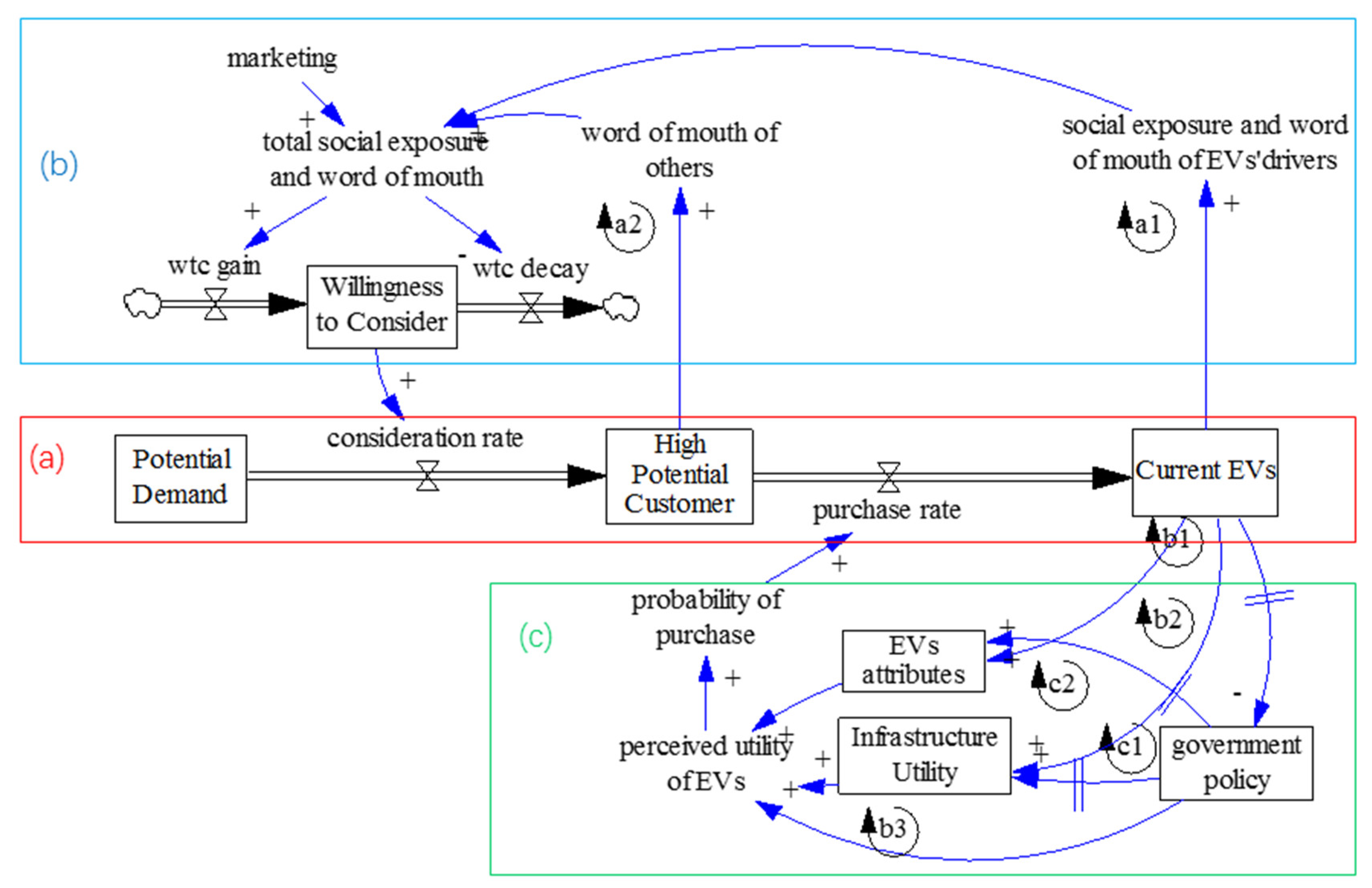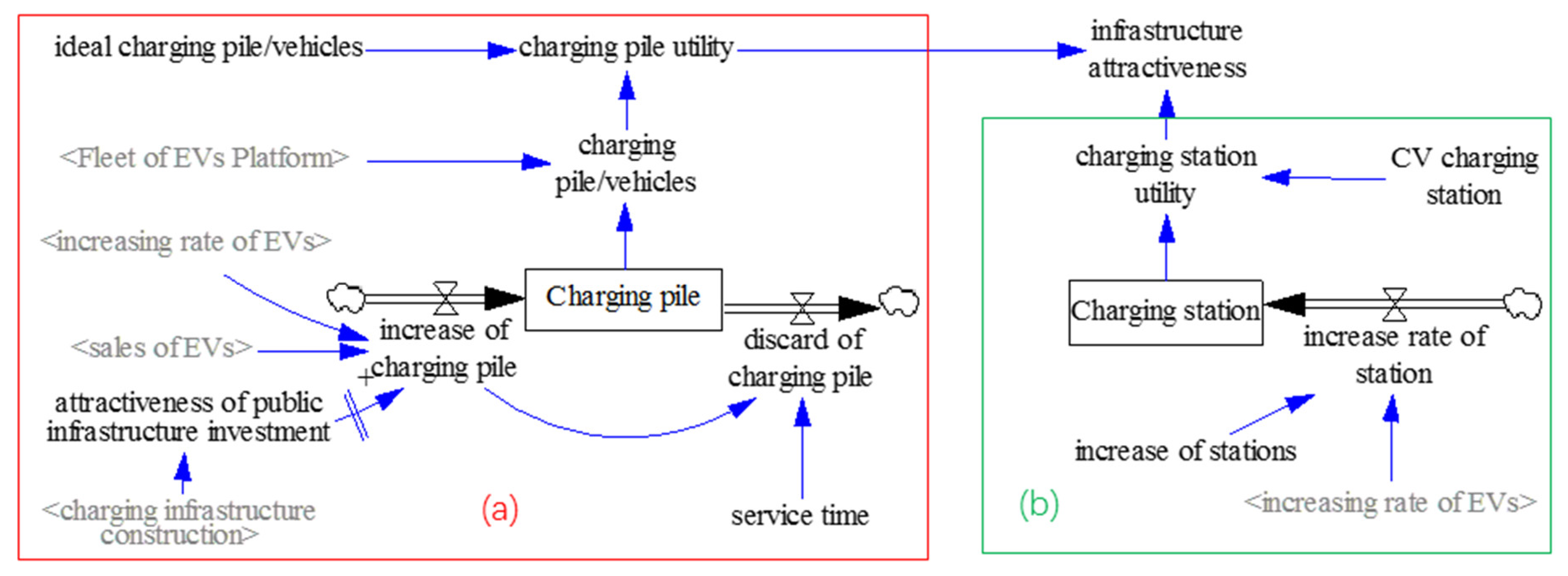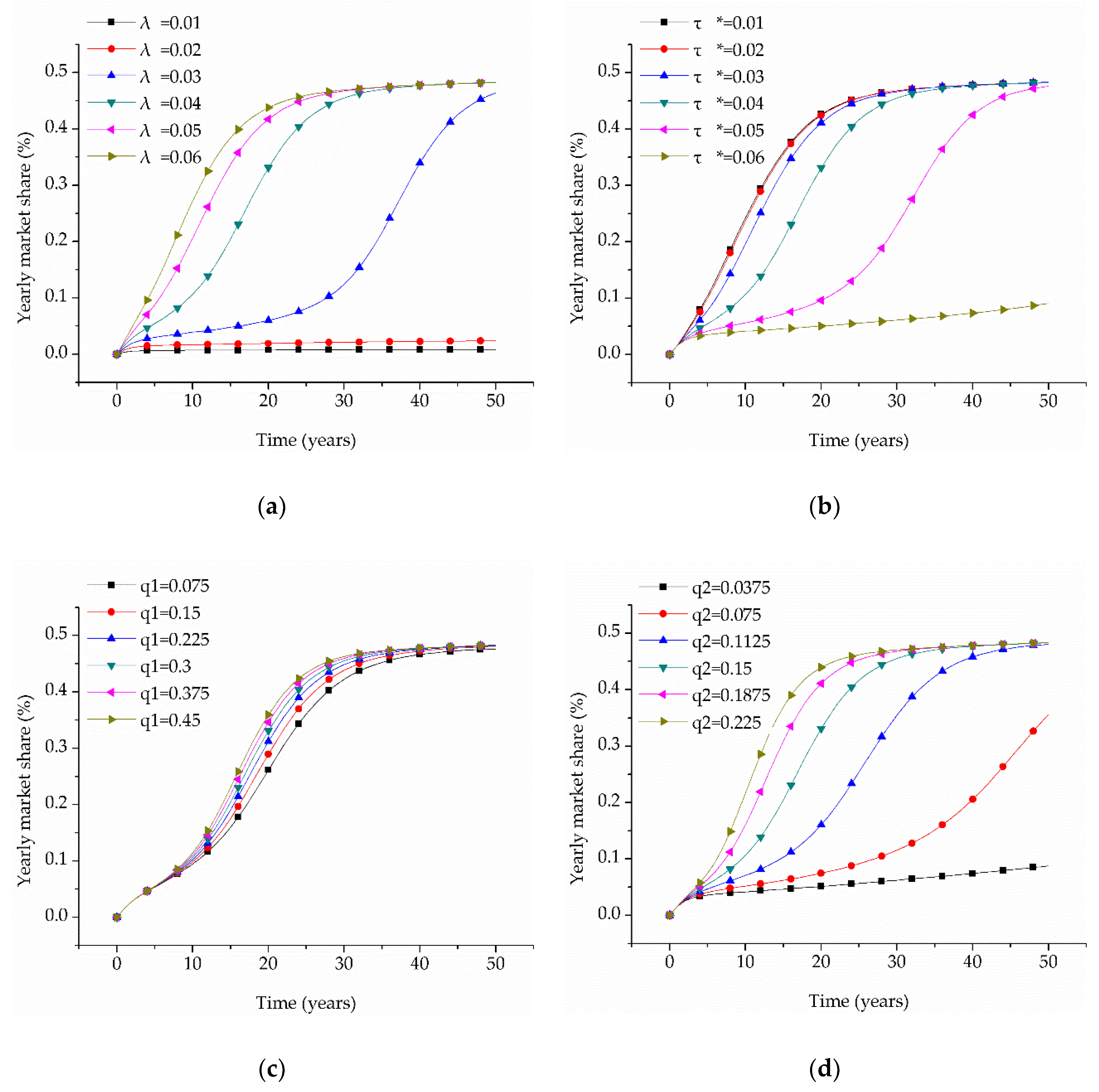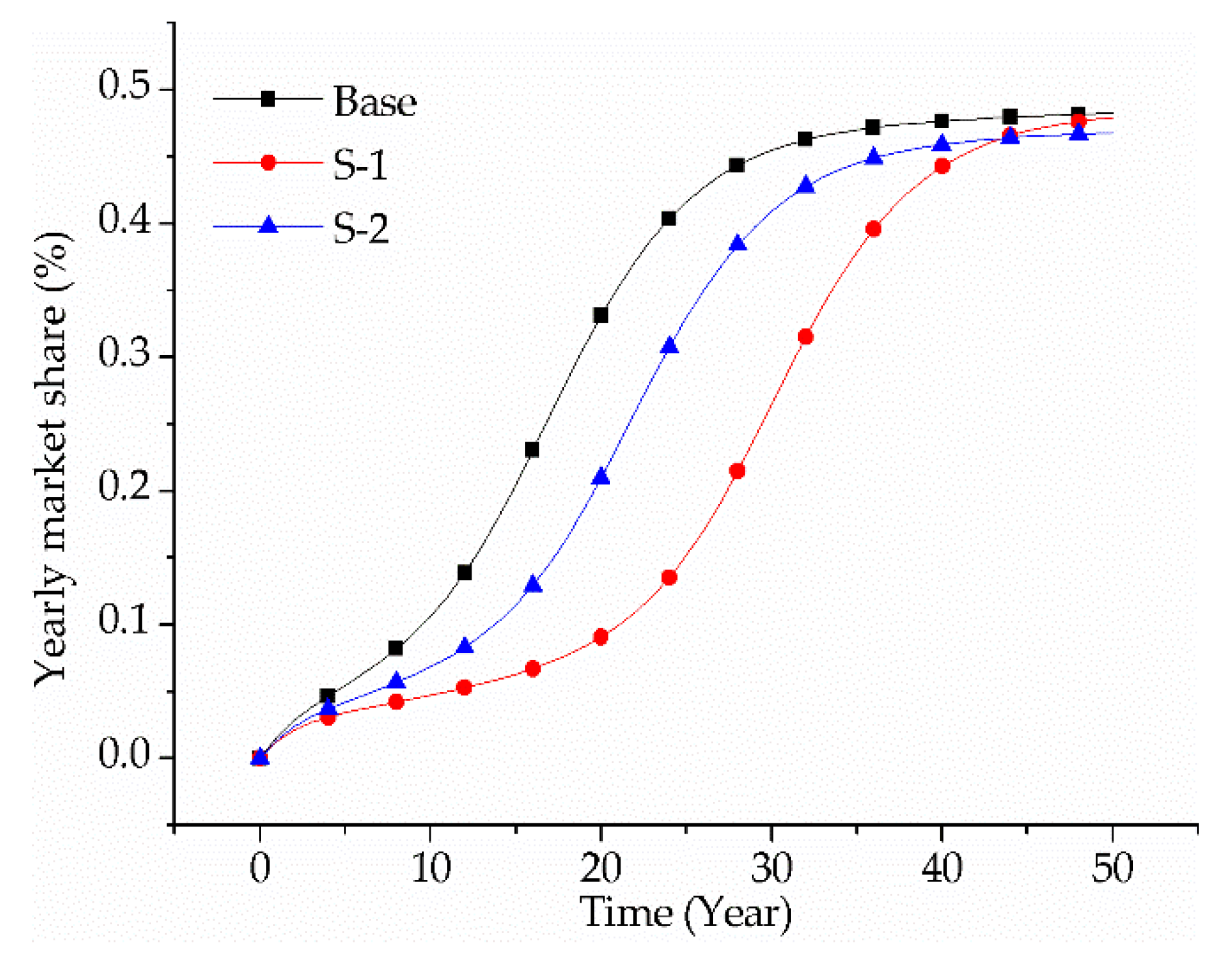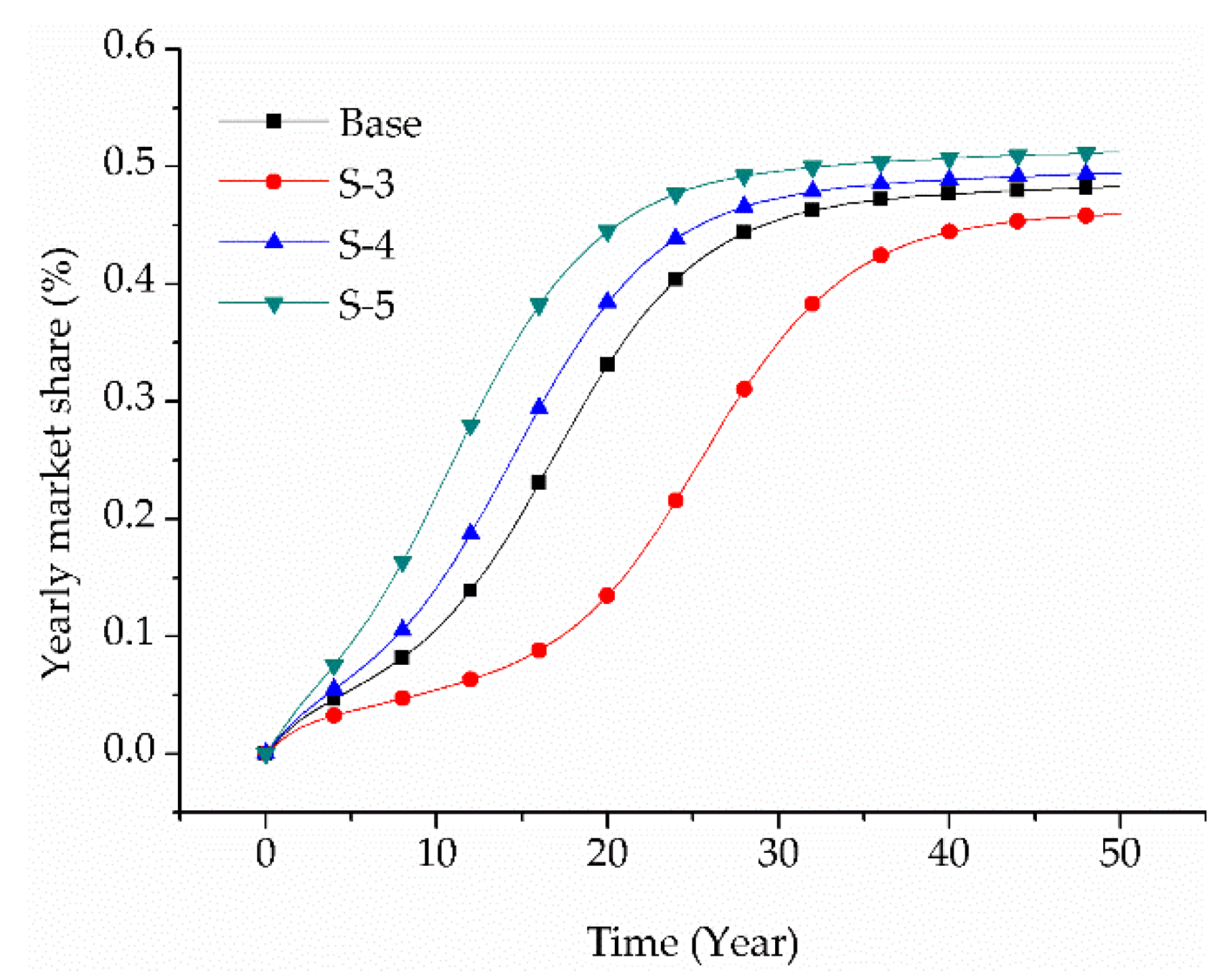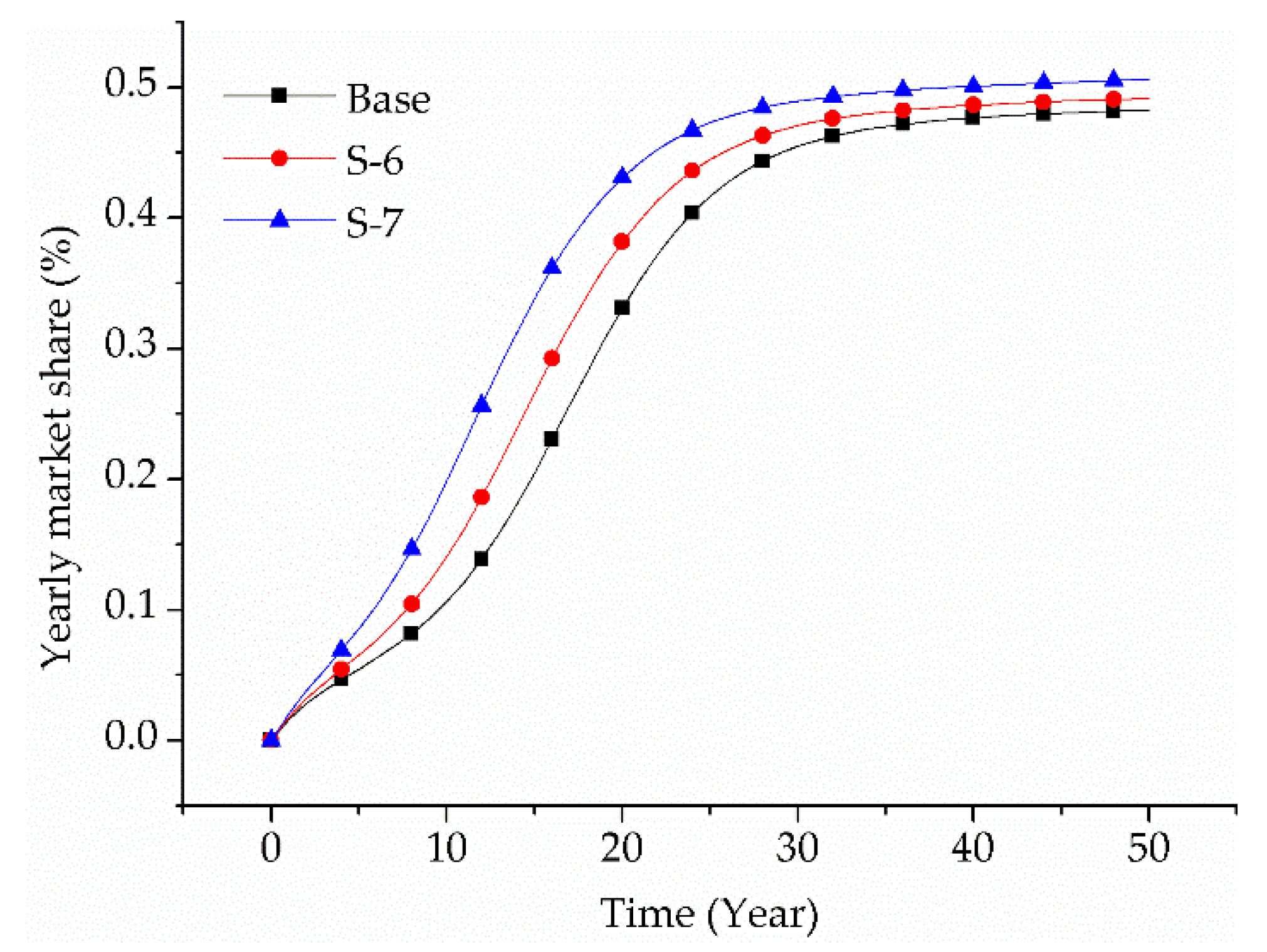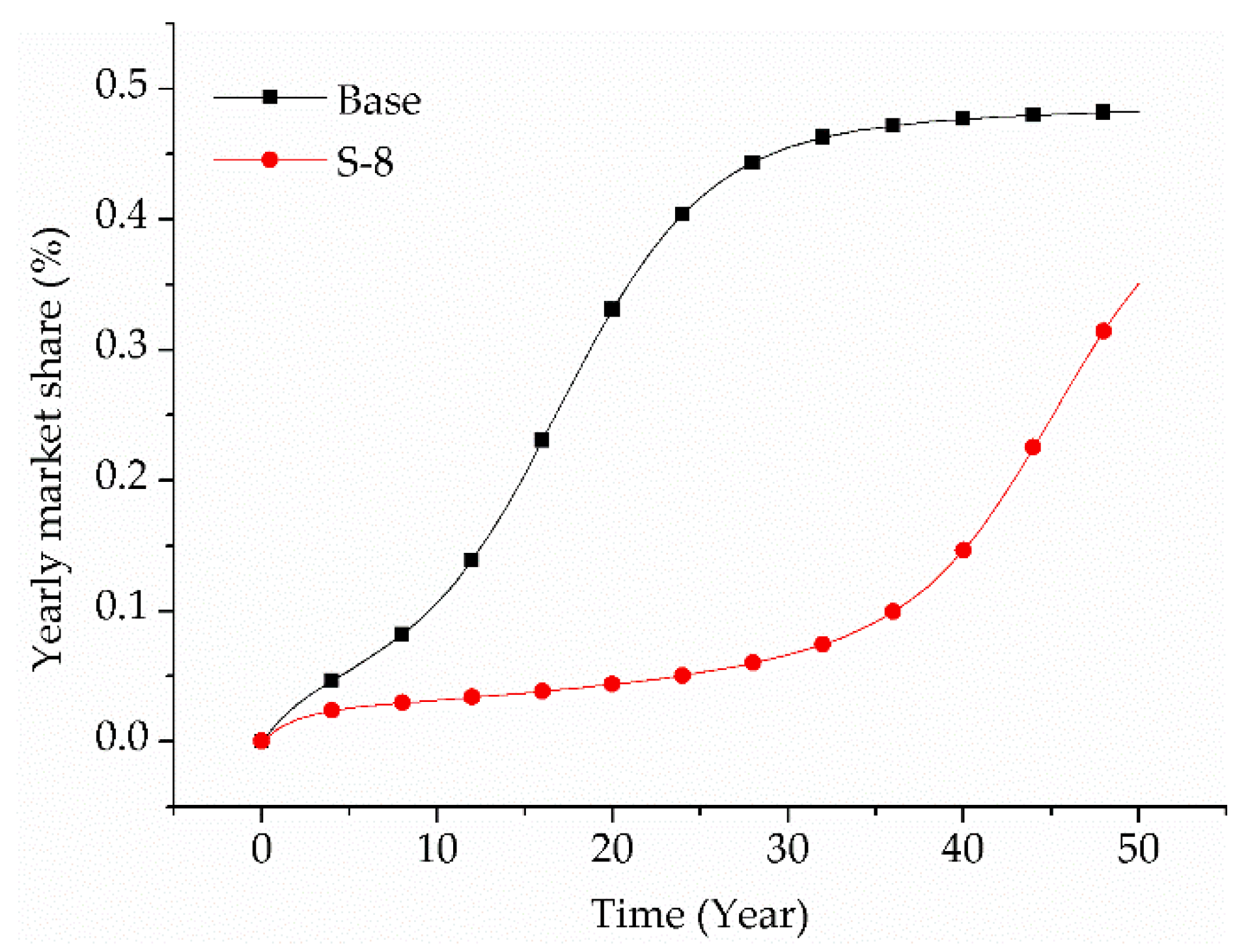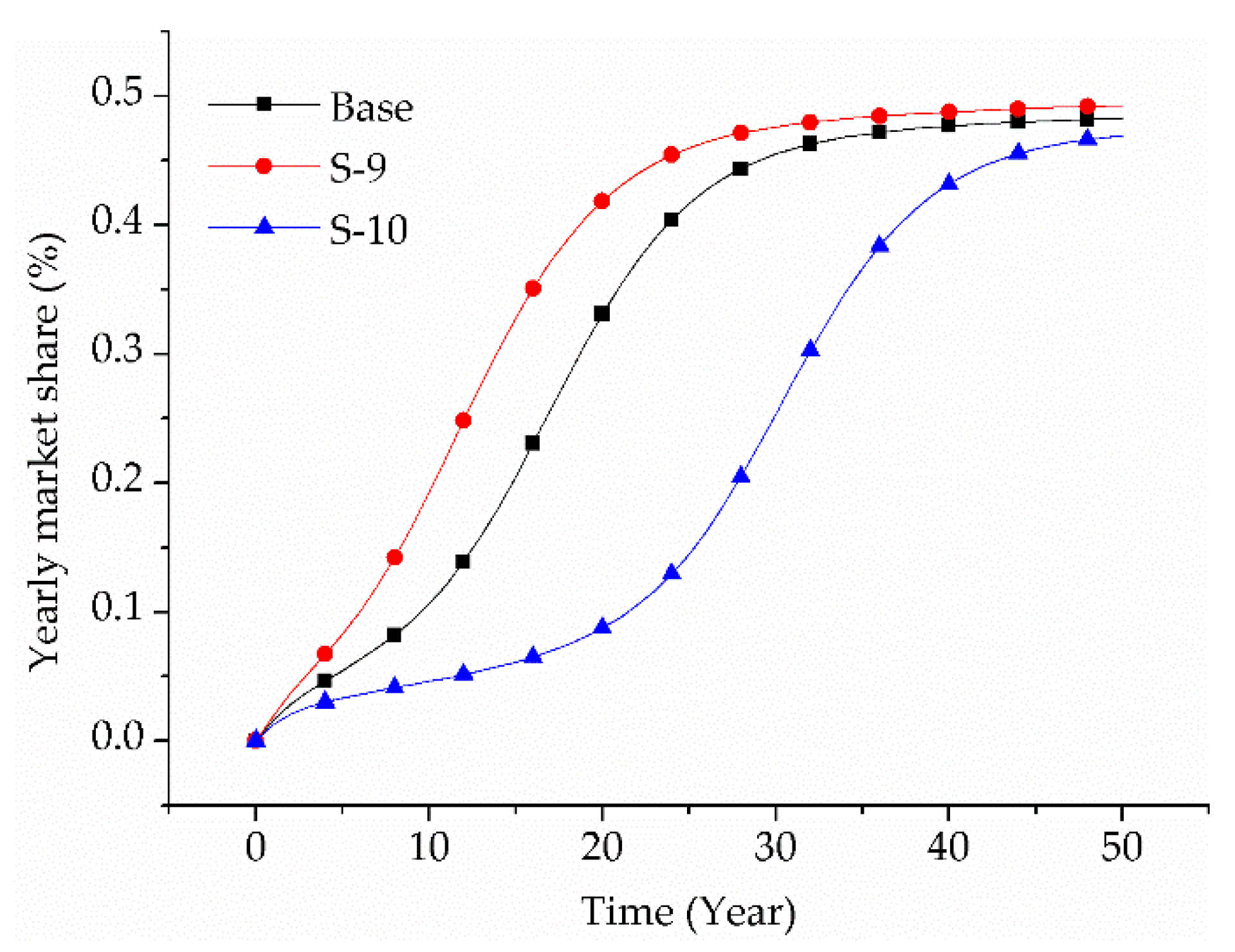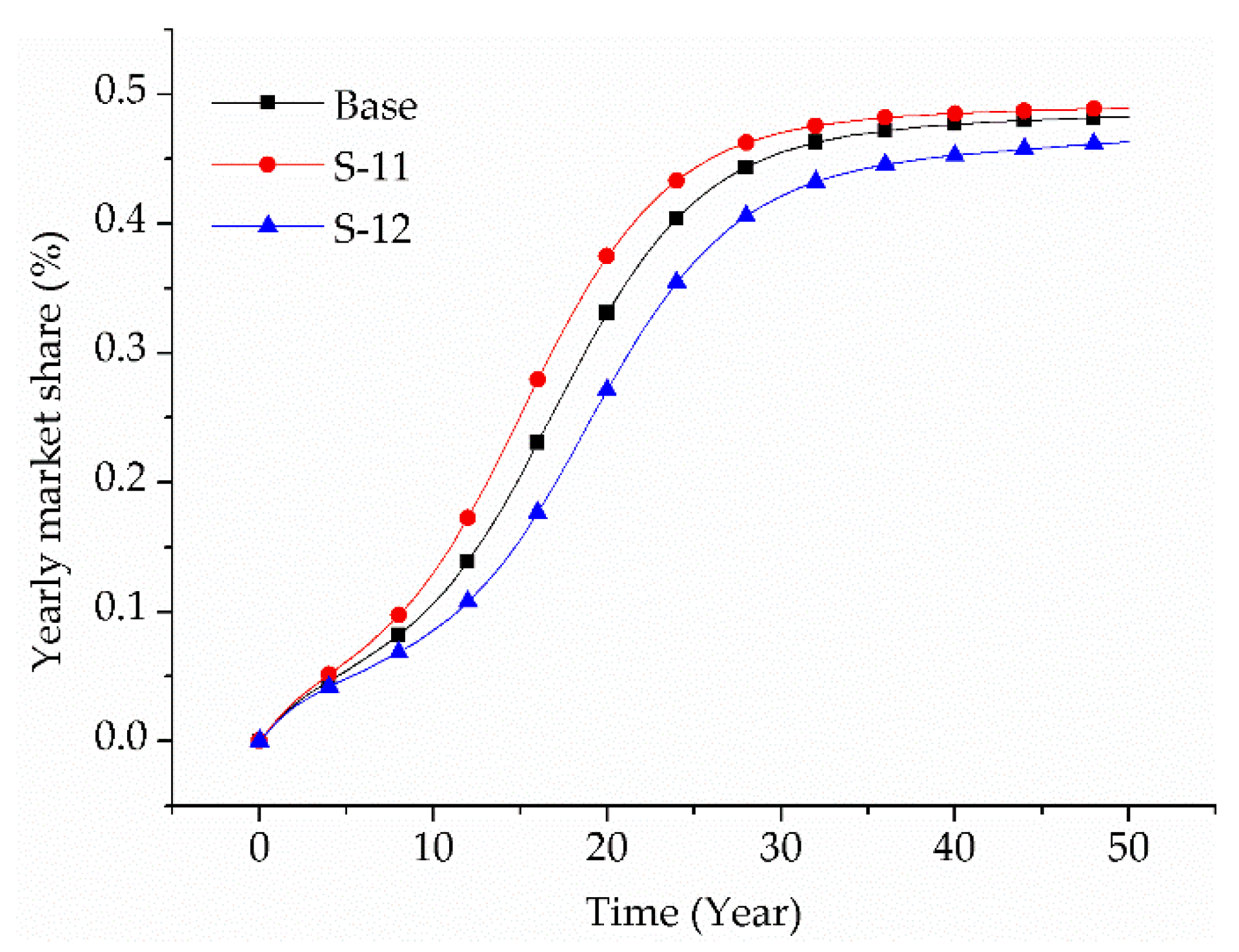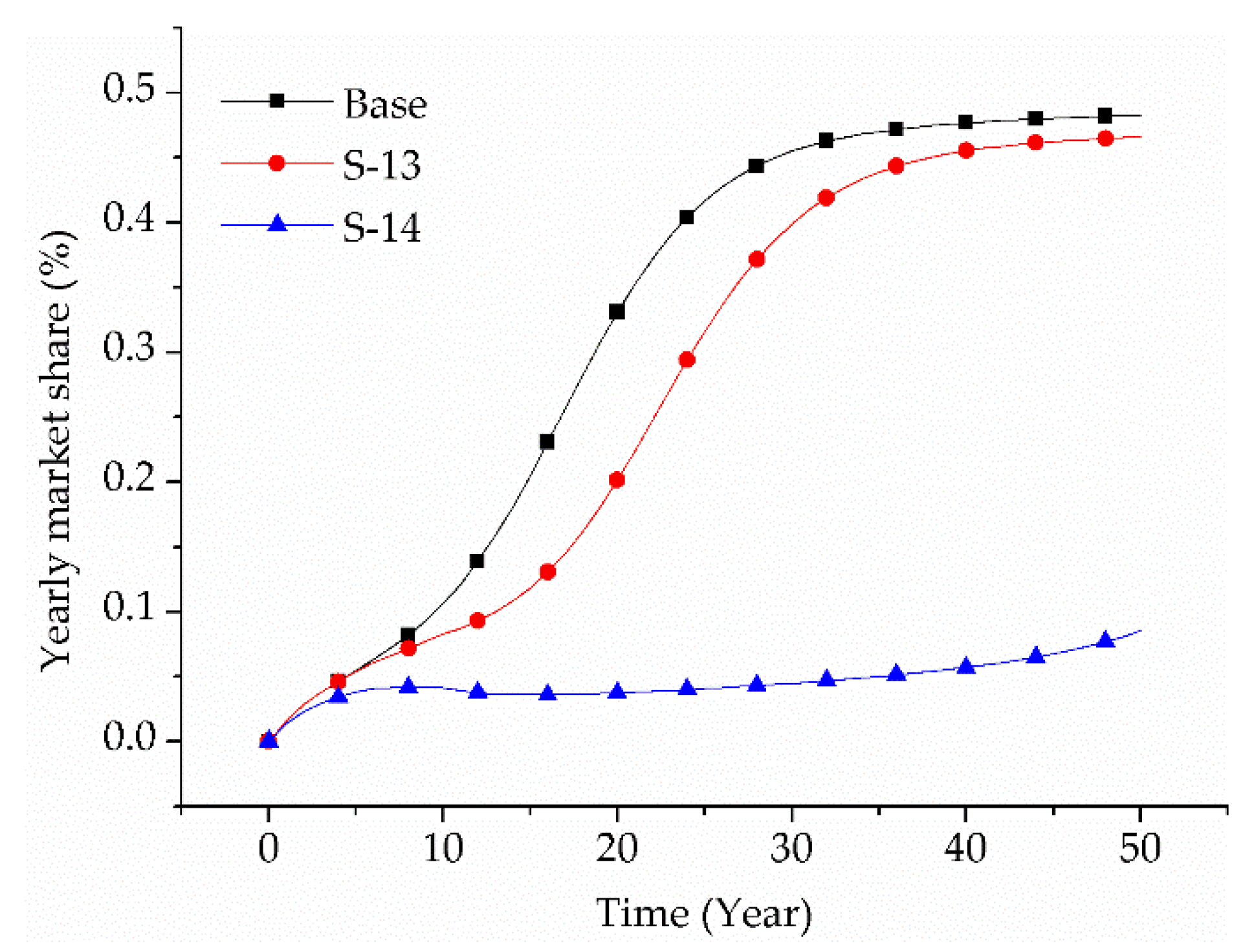1. Introduction
China is promoting a transition to alternative fuel vehicles (AFVs), because conventional vehicles (CVs) consume a large amount of petroleum and cause serious environmental problems. First, “China has been the world’s largest net importer of petroleum and other liquids”, surpassing the United States at the end of 2013 [
1]. Of all oil, 68% is consumed by transportation sector [
1]. Furthermore, the high use of petroleum in the transportation sector generates a high level of greenhouse gases and aggregates air pollution. Especially, automobile emissions generate amounts of particulate matter, such as PM 2.5, which pose a substantial risk to Chinese public health.
In this context, the Chinese government has been determined to promote electric vehicles (EVs) as long-term transportation alternatives, since China’s Twelfth Five-Year Plan period (2010–2015). In the initial stage of EV diffusion, government policy plays a significant role because their long charging duration, short driving range and high price prevent people accepting EVs. For example, in the short term, governments offer subsidies to narrow the price gap and promote the development of charging infrastructure. In the long term, governments will continue to invest in power train technologies to improve the performance of EVs. In particular, policy creates the initial EVs and charging infrastructures, cracking the chicken-and-egg dilemma. Because EVs and charging infrastructure are classic cases of strong complementary goods [
2,
3,
4,
5,
6,
7], consumers will be reluctant to buy EVs without reliable charging facilities. Moreover, the rapid rollout of charging infrastructure requires a sufficient volume of EVs in operation [
8].
Shenzhen is in the first batch of Chinese cities to promote EVs and has become the global leader in the alternative fuel public transportation field. By the end of 2017, the government had replaced all the gasoline buses with electric buses in Shenzhen [
9].
However, private EV promotion is not as good as the rapid penetration of public transportation, and there are many obstacles, despite the great effort of the Shenzhen government. For example, purchase subsidies of EVs reached a peak of
$16,812 in 2016. In addition, private EVs also had a subsidy of
$2924 for private charges in 2015. The government has also implemented purchase restrictions on CVs since 2015. CV consumers must participate in a lottery to get a license plate, while EVs do not have purchase restrictions. EVs have also had a one-hour free parking right since 2015. Furthermore, according to the Shenzhen government, the number of slow charging piles in Shenzhen grew by roughly four-fold within a single year, from nearly 3000 in May 2015 [
10] to 15,134 at the end of 2015 [
11]. By the end of July 2017, Shenzhen had accumulatively built 27,146 slow charging piles [
12]. Charging infrastructure grows rapidly. However, EV promotion does not perform as expected. As of 30 June 2016, Shenzhen had accumulatively promoted 20,574 private EVs, while the Shenzhen government prepared 20,000 EV plates in a car plate lottery policy in 2015 [
13].
Moreover, the sharp decrease of purchase subsidies has posed great uncertainty in relation to EV promotion since 2017. Purchase subsidies come from the central and local governments. Compared with 2016, the purchase subsidies of the central government decreased by 20% from 2017 to 2018 and will decrease by 40% from 2019 to 2020. Before 2017, the local government could offer the same subsidies as the central government. However, the local government has not been able to offer more than 50% of central government subsidies since 2017. In Shenzhen, purchase subsidies of EVs, ranging between 150 and 250 km, decreased to
$7895 in 2017, from
$13,889 in 2016. EV sales of BYD Co., Ltd. (BYD), which is the biggest EV manufacturer in China, dropped by 34% during the first quarter of 2017 [
14]. Unlike in 2016, EV sales of BYD had a 69.85% annual growth according to the annual report [
15]. The annual growth rate of domestic AFV market is 201% in 2015, 86% in 2016 and 69% in 2017 [
16]. The gradual removal of subsidies hits the growth of EVs. Thus, it is essential to deeply understand the effectiveness of cutting subsidies and create an appropriate policy combination in order to guarantee the success of EV penetration.
This research focuses on examining the role of government policies and the development of infrastructure in the private EV promotion in China, rather than the exact prediction of the future EV population. Previous researchers apply system dynamics (SD) models to study the AFV diffusion because the SD models can incorporate complex and uncertain factors [
17,
18,
19,
20]. Struben and Sterman find that the AFV market could be self-sufficient after a critical duration of subsidy policy and marketing efforts [
20]. Shepherd et al. extend Struben and Sterman’s model to study factors affecting diffusion of EVs in U.K. They find that the word of mouth, the vehicle life and the emission rate have more impact than policies or vehicle factors [
18]. Other studies incorporate the similar diffusion structure but add other factors, such as infrastructure developments, communication policies, regulations and the energy price. Meyer and Winebrake emphasize on the importance of the co-evolution of refueling infrastructures in relation to American hydrogen vehicle promotion [
2]. Based on Meyer and Winebrake, Köhler et al. calculate the initial requirement for filling stations for hydrogen vehicles in Germany [
5]. The result shows that the hydrogen vehicle market could be self-sufficient when vehicles and filling stations are both supported. Ardila and Franco [
21] point out that communication policies have a more significant influence than fiscal policies on AFV diffusion in the Colombian market. Benvenutti et al. [
19] find that the banning regulation for CVs is more effective than fiscal policies in relation to AFV promotion in Brazil. Gnann et al. and Plötz et al. reveal that many external factors pose great uncertainty on plug-in electric vehicle (PEV) penetration in Germany [
7,
8,
22,
23,
24]. The result indicates that energy price has a large impact on PEV penetration. Furthermore, subsidizing purchases and depreciation can effectively accelerate PEV penetration. Wolf et al. [
25] propose an empirically grounded agent-based modeling approach to simulate the effect of fiscal policies and social influence on German consumers’ transport model preferences. The result suggests that an exclusive zone for EVs could effectively accelerate the initial diffusion of EVs than fiscal incentives only. Pasaoglu et al. [
26] incorporate the agent-based approach in the SD model to capture the interaction and feedbacks of market participants with conflicting interests. The model simulates the market share of light duty vehicles of 28 members of the European Union. This research also tests the effect of possible factors, “including different oil prices, GDP growth, learning rates, purchase subsidies, and EU emission targets”. Kangur et al. use cross-section survey data to develop an agent-based simulation model. The result shows that EV promotion requires long-lasting policies combining monetary, structural and informational measures [
27]. Shepherd reviewed SD models applied in the AFV diffusion. Shepherd summarized that quantitative research papers typically include a diffusion process, a fleet aging chain and a choice model for purchase decisions [
17].
Although SD models have been widely applied in long-term policy analysis, SD models cannot make the reliable and accurate forecast for the future real world system, because deep uncertainties arise in the long-term future [
19,
20]. Specialized literature on long-term policy analysis argues that SD models contribute to provide insight to future behavior of the real world system [
28]. The SD model helps to test the behavior and response of real world systems when the policy changes. The overall aim of an SD model is to offer an enhanced learning about the real world system, rather than the accurate forecast [
28].
Meanwhile, there are also some statistics methods in AFV diffusion research, such as the correlation analysis [
29], the factor analysis [
30], the linear regression [
31,
32], the logit model [
33], the pooled regression [
34] and the conjoint analysis [
35,
36,
37,
38,
39,
40]. Lin and Wu use correlation analysis to examine the public’s cognition of each factor and analyze the impact of these factors in first-tier cities of China [
29]. Wang et al. apply the factor analysis method and the structural equation model to explore the potential factors that affect consumers’ acceptance of EVs in Shanghai, based on a questionnaire survey [
30]. Sang and Bekhet use the linear regression-stepwise technique to explore factors influencing EV usage intention in Malaysia [
32]. Junquera et al. apply a logit model to analyze consumer attitudes towards EV purchasing intentions in Spain [
33]. Zhang et al. [
34] explore different types of policies by explaining the quick rise of EVs across 88 cities in China. Using a pooled regression, they find that the consumer-oriented policies (e.g., lowering parking fee, subsidy) are more effective than the producer-oriented policies (e.g., R&D support, government procurement). Although many statistics methods reveal consumer preferences in relation to policies and infrastructure, these methods are hard to be incorporated into SD models [
35,
36,
38,
39].
In addition, the conjoint analysis and discrete choice models are also combined to examine AFV preferences in empirical research [
35,
36,
37,
38,
39,
40]. Golob et al. [
40] use the conjoint analysis to examine the commercial fleet demand of AFVs in California. Based on a large-scale survey conducted in Flanders, Lebeau et al. forecast the market potential for plug-in hybrid and battery electric vehicles using a conjoint experiment [
38]. Helveston et al. design a conjoint survey and a discrete choice model on vehicle preferences in the U.S. and China [
36]. Ahn estimated consumer preferences regarding AFV attributes [
35]. Based on a survey of 88 upper income drivers in New York, Kidder et al. [
37] use the conjoint analysis to test part-utilities of different attributes of the car purchase decision. The result suggests that the current price of EVs is unattractive to potential adopters. However, previous conjoint analysis research mainly focuses on vehicle attributes and find that CVs are still most consumers’ choices. Moreover, conjoint analysis is rarely incorporated into an SD model to study EV diffusion.
In summary, although the conjoint analysis is rarely incorporated into an SD model, discrete choice models are very common in SD models in relation to AFV diffusion. It is a new idea to incorporate the conjoint analysis and the discrete choice model into an SD model. Then, previous conjoint analyses focus on vehicle attributes, despite the fact that policies and the development of infrastructure drive the early diffusion of EVs. This research expects to use conjoint analysis to quantify consumer preference for policies and charging infrastructure, rather than vehicle attributes. Moreover, most previous research focuses on AFVs, which can be refueled within a short time [
2,
5,
20,
21,
26,
38,
41,
42]. Some research only considers the number of charging stations [
2,
3,
4,
5,
6,
43,
44]. This research proposes further study on the development of charging infrastructure from three aspects: charging piles, charging stations and charging positions. Furthermore, most research ignores the phase out strategy of policies, which is a dilemma currently faced by the government, although some research tests the duration of policies [
19,
20]. One of contributions of this research is evaluating the influence of the phase out strategy of purchase subsidies.
There were five primary objectives of this research: (1) to develop an SD simulation model of EV promotion in Shenzhen China; (2) to incorporate the conjoint analysis and the discrete choice model into the SD model to reveal consumer preference regarding EVs; (3) to examine the role of government policies and the charging infrastructure in the EV industry in China; (4) to evaluate the influence of the phase out strategy of incentive policies; and (5) to offer more insight into EV promotion systems.
The structure of the paper is as follows:
Section 2 describes an SD model, which shows the system structure of EV diffusion. After formulating the model, a questionnaire survey and a conjoint analysis collect parameters of consumer preference. Then, a parameter analysis examines the influence of uncertainties and finds the proper value of parameters. In
Section 3, a scenario analysis tests the effect of policies, infrastructure development plans, the duration of policies and the phase out strategy of purchase subsidies.
Section 4 compares the results and methods of the conjoint analysis and the SD model with previous studies.
Section 4 discusses the implication of the proposed approach to other countries and future research. Finally, in
Section 5, suggestions and policy implications are provided to the government in order to guarantee the rapid penetration of EVs.
4. Discussion
4.1. Conjoint Analysis
Previous conjoint analysis research mainly focuses on vehicle attributes (e.g., costs, driving range, refuel or charging time, fuel type, body type, engine displacement, brand) to explore consumer preference for AFVs, without considering policies and the charging infrastructure. Lebeau et al. find that the up-take of EVs is most sensitive to vehicle prices, the energy price and the pace of technological improvement (e.g., driving range) [
38]. Ahn find that gasoline-fueled cars will still be most consumers’ first choice [
35]. Helveston et al. find that Chinese consumers are more willing to adopt battery electric vehicles than American consumers [
36]. Most previous research find that CVs are still most consumers’ choices because they only focus on vehicle attributes without considering policies and the charging infrastructure.
Unlike previous research, conjoint analysis in this research focuses on qualitative factors, such as regulations (e.g., driving and purchase restrictions), operation subsidies, charging places, the rental model and the battery warranty. Due to regulations, policies and the charging infrastructure are critical factors regarding EV promotion. Moreover, a conjoint analysis and a discrete choice model are incorporated into an SD model. We can further test the effect of specific factors. The results show that subsidies, driving restrictions and purchase restrictions can effectively attract consumers to adopt EVs. Conjoint analysis of other countries should add more factors, such as policies, infrastructures, socio-demographic factors, the lifestyle and the environmental awareness [
50,
51,
52].
4.2. The Effects of Fiscal Policies
In Shenzhen, it takes 10 years for EVs to enter the rapid growth stage with purchase subsidies in the base scenario. Without purchase subsidies, it takes 22 years. In particular, the gradual removal of purchase subsidies will lead to a four-year delay of the rapid growth stage, although it will not lead to the failure of EV promotion in Shenzhen. However, cutting purchase subsidies in cities that do not have purchase restrictions will prevent EVs entering the rapid growth stage in 50 years.
Purchase subsidies are still the key factor for EV promotion in China. This is very much in line with previous research in Austria, German, Switzerland, EU, Italy and Norway [
22,
26,
31,
44,
53,
54,
55,
56,
57,
58], which suggests that up-front price reduction is the most powerful incentive in promoting AFV adoption. However, literature pays little attention to the effect of the phase out strategy of subsidies. In addition, China, Norway, Denmark, U.S. and many other countries plan to trim subsidies of EVs in next few years. Thus, it is essential to evaluate the effect of cutting subsidies, which may delay the EV diffusion.
Moreover, cutting subsidies has both positive and negative effects. On the one hand, the government hopes to eliminate the subsidy-reliant companies and speed up industrial integration by cutting EV subsidies [
14]. Manufacturers are also forced to reduce costs and accelerate technology improvement. On the other hand, cutting subsidies hits EV penetration and causes an uncertainty influence on EV promotion. Thus, both the central and local governments should adjust policies according to the policy combination, the EV promotion and the industrial development. Government can lessen the negative effect of cutting subsidies by implementing other policies, such as a longer battery warranty and better charging infrastructure. The SD model contributes to test the response of EV diffusion system when policies change.
4.3. The Effects of Charging Infrastructure
As for the charging infrastructure aspect, charging piles and their location are more important than charging stations, which is neglected by previous research. Charging piles in communities, roadsides, work places, and other parking places are much more important than charging stations for private EV users. Because private EV drivers are reluctant to charge far away. Literature also emphasizes that the installation of a charging network on freeways is an absolute necessity [
5,
17,
57]. Moreover, the proper rate of EVs and charging piles is 1:1.5.
This research also answered the chicken-and-egg problem. The government must take the initiative to promote the infrastructure development because charging enterprises are not willing to construct charging infrastructure without incentive policies due to the low driving force of current EVs. The government should place more emphasis on the construction of charging piles, especially in the parking lots of old communities. Before 2016, the Chinese government put more emphasis on the construction of large charging stations. However, these charging stations are not entirely used and depreciate quickly, which generates a great amount of waste. Now, the Chinese government is turning to the construction of charging piles.
Moreover, EVs grow rapidly when fiscal incentives and the charging infrastructure were both supported [
6,
41,
59]. All of the leading countries in AFV promotion offer a great amount of purchase subsidies and heavily invest in charging or refueling infrastructure, such as U.S., Japan, U.K., Norway, German, and China. In particular, Nissan reported that Japan has 40,000 car chargers compared to 34,000 gas stations [
60]. Analyzing the process of EV diffusion in these countries, subsidies have little effect, if there are very few charging facilities.
To promote private EVs, other countries and other research should focus on charging pile construction and pay more attention to their locations.
4.4. The Effects of Regulations
In addition, fiscal policies and the charging infrastructure, regulations also play an important role in EV promotion [
34,
36,
50,
61]. As shown in scenario analysis, implementing purchase or driving restrictions on CVs will boost EVs within 10 years. Moreover, driving restrictions are more effective but less controllable than purchase restrictions. With driving restrictions, more families would consider EVs for their first car, since EVs can be used most of the time. Families that already have a CV would also intend to buy an EV due to the inconvenience of CVs. Thus, without purchase restrictions, driving restrictions will lead to more redundant purchases, which will increase traffic congestion. Driving restrictions are also difficult to remove because of traffic congestion. Thus, driving restrictions are more effective, although purchase restrictions are more controllable in relation to the promotion of EVs and control of traffic congestion. Purchase restrictions effectively force consumers, who have a strong demand for vehicles, to consider EVs as a substitute, since the success rate of the license plate lottery is currently lower than 1% in Shenzhen. Eight cities that have purchase restrictions take up more than 70% of the total private EV sales in China [
16].
Moreover, the banning regulation in Brazil increase the diffusion rate [
19]. Some European countries also focuses on punishments for the use of high emission vehicles, which also helps to promote EVs, such as Finland, France and U.K. [
62,
63,
64]. Accommodation lane access also promote EVs in the U.S. [
36], Norway [
55,
56] and Germany [
25].
Other countries can adopt purchase restrictions and driving restrictions according to their traffic conditions. China can also adopt other countries’ regulations to promote EVs, such as punishments for the use of high emission vehicles and accommodation lane access. Moreover, this research suggests to apply conjoint analysis to quantify the effect of regulations for future research.
4.5. Simulation Parameters
Because deep uncertainties arise in the long-term future, SD models cannot make the reliable and accurate forecast for the future EV promotion system. A parameter analysis is conducted to determine the proper value of some highly uncertain parameters to make EV diffusion process consist with national strategic planning for EVs and other similar research. Then, we can focus on analyzing the effect of policies, infrastructure development plans, policy durations and the phase out strategy.
The EV diffusion model contains two stages: (a) the consideration stage, and (b) purchase stage. In the consideration stage, we find that marketing effectiveness (λ), reference rate of the total social exposure (τ*), and contact effectiveness of EV drivers (q1) have remarkable influence on EV diffusion. Contact effectiveness of other drivers (q2) has little effect.
In the purchase stage, policies can be divided into three levels. Purchase subsidies, driving restrictions by tail number, and purchase restrictions significantly improve EV diffusion. A lifetime battery warranty and free parking and tolls have some effect. A rental model has little effect. Charging piles and charging place are more important than charging stations.
4.6. Limitation
This research inherits the general structure of SD literature, verifies many conclusions from literature and comes up some new findings. However, because parameters conditioning EV diffusion are high uncertain, SD models cannot make a reliable and accurate forecast for the future EVs population. This research focuses on the effect of policies and infrastructure development, assuming that the technology and service remain the same. For future research, we suggest to combine some future-oriented technology analysis (e.g., Delphi and technology road-mapping) to offer a better understanding of the long-term future. In addition, the development of charging infrastructure is formulated in a simple approximation. In future research, a GIS- or matrix-based formulation could better measure the distribution of charging infrastructure.
5. Conclusions
This research focuses on building an SD model in Shenzhen to identity the general trends of EVs and provide suggestions for the government rather than exactly forecast the future EV population. This model can be applied to other studies in analyzing diffusion factors of AFVs in other countries. This SD model tests the effect of different policies, infrastructure development plans, policy durations and the current decrease rule in relation to purchase subsidies. The government can also use this model to test the influence of the phase out strategy of other policies. Several conclusions can be drawn from this research.
Firstly, policies can be divided into three levels, according to their effects. Purchase subsidies, driving restrictions by tail number, and purchase restrictions significantly improve EV diffusion. A lifetime battery warranty and free parking and tolls have some effect. A rental model has little effect. The critical duration time of policies for EV diffusion is 11 years. Secondly, the effect phase out strategy of subsidies is highly uncertain. Thus, government needs to work on a long-term policy for electric mobility and a proper phase out strategy. Additionally, charging piles and their location are more important than charging stations.
EV penetration will take a long time and create challenges in relation to policy design and application. In the short term, policy and infrastructure development play the important role in promoting EVs by reducing the convenience of CVs and increasing the attractiveness of EVs. In the medium term, the phase out strategy of policies has great uncertainty effects. In the long term, the technological development of EVs is the decisive factor in relation to the EV market share. Thus, the government needs to work on long-term policies for EVs and adjust policies according to the policy combination, EV sales, technology improvement and charging infrastructure. This model allows the government to foresee the effect of policies and test the impact when policies change.
The improvement of this research includes four aspects: firstly, the conjoint analysis is incorporated into an SD model to reveal consumer preferences; secondly, the development of charging infrastructure is modeled well; thirdly, the effect of specific policies and charging infrastructure development plans is evaluated by a scenario analysis. Finally, the duration of policies and effect of the phase out strategy of subsidies are also tested in this research.
